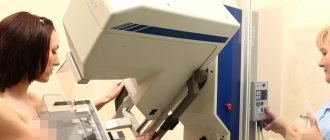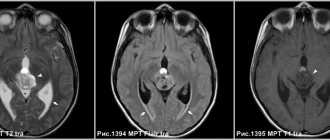The term “male infertility” hides a number of pathologies that disrupt the functioning of the male reproductive system and significantly complicate the conception of a child. The diagnosis is made if pregnancy does not occur within a year with regular sexual activity without the use of contraception. In the article, specialists from the Center for Reproductive Health “SM Clinic” will examine in detail the causes, signs, symptoms and treatment options for infertility in men of different ages, identify risk factors and talk about methods for diagnosing the disease.
Diagnosis of male infertility:
Diagnosis of male infertility is based on a comprehensive assessment of the condition of the male reproductive system; an andrologist conducts an examination in a certain sequence. Diagnostics begins with a minimum and expands as necessary.
The minimum algorithm for examining a man with infertility:
(this algorithm allows you to verify the diagnosis and identify disorders of the ability to fertilize in men, and allows you to assess the anatomical and functional state of the organs of the reproductive system).
1.
Consultation (collection of anamnesis, complaints) and examination by an andrologist.
2.
Evaluation of spermogram indicators - assesses male fertility (sperm quality). It is the starting point for the need for further action (the test is taken by masturbation in a separate room, before this there are 3 days of abstinence from sexual intercourse, do not drink alcohol, do not go to the bathhouse). Types of pathospermia.
3.
MAR test – excludes immune infertility (preparation is the same as for taking a spermogram).
4.
Ultrasound + Doppler of the scrotal organs - study of the testicles, appendages and blood supply to these organs. Excludes surgical, inflammatory and physiological pathology.
5.
TRUS of the prostate gland and seminal vesicles is a more detailed examination of the prostate gland, which allows you to examine its structure and exclude acute and chronic inflammatory processes.
A complete algorithm for examining a man with infertility:
(carried out after a minimal algorithm in order to clarify the diagnosis or if there are complaints from the patient).
1. Hormonal status - blood test for the main hormones responsible for the normal course of spermatogenesis and male libido (blood is donated in the morning, on an empty stomach from 9.00 to 10.00)
2. Genetic studies - performed as prescribed by an andrologist based on the clinical situation (the direct indication for the study is severe pathospermia).
3. PCR - diagnosis of STD infections - exclude major sexually transmitted infections and their possible impact on decreased sperm quality and lack of conception, miscarriage or fading pregnancy (smear from the urethra, do not urinate 2 hours before the test).
4. Sperm culture (spermogram) - a study of the ejaculate is performed in cases of increased leukocytes or the appearance of bacteria in the semen (the test is taken by masturbation in a sterile container, abstinence is not necessary).
5. Prostate juice - (prostate secretion) - excludes the inflammatory process in the prostate gland - prostatitis (before the analysis, 3 days of sexual abstinence are required).
6. Determination of the level of free radicals (ROS) - one of the factors that can reduce male fertility ROS - overproduction of reactive oxygen species (ozone, free radicals, hydrogen peroxide). In small amounts, ROS are necessary for the normal regulation of sperm function (hyperactivation and acrosomal reaction). But excessive production of ROS leads to damage to the sperm membrane, a decrease in their motility and impaired fertilizing ability. In addition, ROS directly damage chromosomal DNA and initiate sperm apoptosis.
7. Acrosomal reaction - (these are chemical changes on the head of the sperm that allow it to penetrate the egg) - when the sperm comes into contact with the transparent area of the egg shell, the acrosome of the sperm undergoes an acrosomal reaction, which normally occurs only in morphologically normal sperm and allows them to penetrate into the egg .
8.Electron microscopic examination of spermatozoa (NEW)
– a new method for a more detailed study and identification of pathological internal structures in sperm and the contents of seminal plasma.
9. Biochemistry of ejaculate - the study of the composition of seminal plasma, reflects the work of such organs as the prostate gland, seminal vesicles and epididymis. (examine the level of fructose, citric acid, neutral alpha glycosidase, prostatic acid phosphatase, zinc).
10. Morphology study according to Kruger - a more in-depth study of sperm morphology when performing a regular spermogram (performed together with a spermogram). Wrapped spermogram – it includes a standard spermogram (indicators recommended by WHO) + MAR test (IgG; IgA) + Kruger morphology.
11. Kurzrock-Miller test; Shuvarsky test - identification of an immunological conflict between a man and a woman at the level of the cervix (cervical factor, postcoital test).
12.HLA – typing of a married couple (in case of non-pregnancy). It is carried out to determine histocompatibility antigens in spouses. Venous blood is collected and leukocyte cells are isolated from it, on the surface of which are histocompatibility antigens.
13.Diagnostic testicular biopsy - performed as prescribed by an andrologist, in cases with azoospermia (necessary for making an accurate diagnosis and choosing further treatment tactics).
14. PSA - prostate specific antigen, the test is performed on all men over 45 years of age.
15. Laboratory diagnostic methods - prescribed by a doctor according to indications: general urinalysis, urine culture, general blood test, blood biochemistry, etc.
16. Determination of tumor markers - the appointment is carried out by a doctor according to indications.
Physical examination
The first step in determining infertility in a man is always a urogenital examination, which is carried out to identify anomalies in the anatomical structure of the genital organs. During a thorough physical examination, your doctor may determine the presence of the following conditions that may interfere with conception:
- Hypospadias is a disease characterized by displacement of the external opening of the urethra. In the presence of such a condition, the hole may be located outside the head of the penis, which leads to the impossibility of seminal fluid entering the woman’s body.
- Phimosis is a severe narrowing of the foreskin, which prevents the normal release of sperm;
- Cryptorchidism is the failure of the testicles to descend into the scrotum, which is an obstacle to normal spermatogenesis.
Treatment of male infertility:
There are two approaches to treating male infertility, both of which require the physician to make realistic predictions about the potential success of treatment before administering therapy. Untested medications and therapies should not be used in treatment. Any treatment of male factor must be accompanied by optimization of female sexual functions.
1. Empirical path
– without identifying the reasons that led to infertility, for example, the use of artificial insemination methods, if there is at least one sperm, then it is already possible to carry out the IVF/ICSI procedure. Since infertility is not life-threatening for a man, it is necessary to choose methods of empirical therapy that do not produce severe side effects.
2. Pathogenetic pathway
– first the cause is diagnosed, and then treatment is selected. During the consultation, the andrologist, based on the results of the examination, provides complete information about possible options for treating infertility taking into account the female factor and proposes an algorithm for managing the couple.
There are 2 main sources of bacterial infection.
- Widespread bacterial vaginosis in women. Often, in women examined for inflammatory diseases of the genital organs, bacterial vaginosis is detected in 25% of cases. The cause of bacterial vaginosis is small opportunistic rod flora, which often leads to infection of the urogenital tract of men. The cause of bacterial vaginosis is sluggish bacterial and persistent viral infections, hormonal disorders and other causes that cause secondary immunodeficiency.
Table of microorganisms most often found in the genital organs of women with inflammatory diseases caused by Gardnerella vaginalis and non-spore-forming bacteria.
- 2. The prevalence of oral-genital and anal sexual intercourse is also a source of infection of the urogenital tract of men. In the first case, infection occurs predominantly with streptococcal or staphylococcal microflora, in the second case - with Gr-bacillus flora (Proteus, Klebsiella, Escherichia coli, etc.)
The mechanism for the development of bacterial inflammation in the urogenital tract, when its cause is not sexually transmitted infections, is presented.
Treatment of these diseases will only be successful and definitive if an integrated approach is implemented, which is based on knowledge of the etiopathogenetic mechanisms of inflammation, immunoreactivity to this inflammatory process and functional changes in the genital organs.
Akopyan Nerses Grigorievich.
Urologist, andrologist, sex therapist, candidate of medical sciences.
Urologist, andrologist Akopyan Nerses Grigorievich.
Back to list of articles
General recommendations for patients with infertility:
- Regular sexual intercourse should be at least once every 3-4 days;
- Smoking cessation, smoking leads to increased oxidative stress and the appearance of excess ROS. Nicotine abuse is considered to be smoking more than 10 cigarettes per day.
- Refusal of alcohol and excessive alcohol consumption are often accompanied by hypogonadism and subfertility. Alcohol abuse is considered to be drinking more than 60 grams of alcohol per day.
- Stress is a risk factor leading to testosterone deficiency and a decrease in the number of sperm in the ejaculate.
- Replacing swimming trunks with looser underwear - overheating of the testicles negatively affects spermatogenesis. It is recommended to avoid visiting baths, saunas, steam rooms, etc.
- Moderate physical activity has a tonic effect on a man’s sexual activity.
- Rational nutrition, body weight control - excess body weight is accompanied by an increase in the peripheral conversion of testosterone to estrogens, and the adipose tissue hormone leptin has an inhibitory effect on the synthesis of the hormones testosterone and LH.
! For convenience, the main treatment measures are presented to patients in the form of tables.
Factors provoking the disease
Male fertility can be affected by:
- prolonged exposure to harmful chemical compounds (industrial chemicals, heavy metals);
- contact with radiation;
- frequent overheating of the scrotum (visiting saunas, baths, taking a hot bath, wearing excessively warm and tight underwear).
Other possible predisposing factors may include:
- maintaining a passive lifestyle without physical activity;
- excess weight combined with sedentary and sedentary work;
- addiction to alcohol and nicotine;
- drug addiction;
- psycho-emotional shocks;
- hard physical labor;
- uncontrolled use of medications that can affect the functioning of the reproductive system (hormonal and psychotropic drugs);
- abuse of drugs to accelerate muscle growth;
- long-term use of medications, for example, during chemotherapy, treatment of peptic ulcers, fungal infections;
- various mutations.
It has been proven that the risk of reproductive dysfunction in men is higher if their direct male relatives have encountered a similar problem.
Table No. 1: The main algorithm for the treatment of male infertility:
| Diagnosis: | Treatment: | Alternative methods: |
| Varicocele | Surgery (microsurgical surgery, laparoscopy). | IISM; IVF/ICSI. |
| Ideopathic infertility (infertility with an unknown cause) | The empirical path of conservative therapy (often does not give encouraging results). | IISM; IVF/ICSI; (in case of ineffectiveness - IISD). |
| Immune infertility | Conservative therapy (quite often ineffective), sperm capacitation is indicated. | IISM; IVF/ICSI. |
| Endocrine infertility | Conservative therapy depending on the hormonal imbalance is presented in Table No. 2. | IISM; IVF/ICSI; (in case of ineffectiveness - IISD). |
| Genital infections | Comprehensive treatment for both partners. Drugs are selected depending on the pathogen isolated. | Carrying out AISM and/or IVF/ICSI is possible only after conservative comprehensive treatment of both partners. |
| Inflammatory diseases | Antibacterial therapy using auxiliary methods: massage, physiotherapy, acupuncture, etc. | IISM and/or IVF/ICSI. |
| Sexual and/or ejaculatory dysfunction | Conservative therapy, surgical treatment | IVF/ICSI (with possible sperm retrieval through testicular biopsy). |
| Congenital anomalies of the reproductive system | Surgical correction | IISM; IVF/ICSI; IISD. |
| Azoospermia | Diagnostic biopsy of the scrotal organs with histological examination | ICSI with an attempt to obtain sperm by biopsy of the testicles and epididymis. |
| Bad habits, environmental and other factors | Elimination of the influence of harmful factors | IISM; IVF/ICSI. |
Etiology and pathogenesis
According to modern concepts in reproductive medicine, there are 4 forms of male infertility.
- Secretory infertility associated with testicular disease
- Excretory infertility not associated with testicular disease.
- Mixed form of infertility is a combination of secretory and excretory forms.
- Idiopathic infertility is a condition when pregnancy does not occur in the absence of genital diseases.
Primary secretory pathology of the testicles can be caused by congenital malformations of the genital organs (testicular anomalies, cryptorchidism, varicocele, Klinefelter syndrome, Del Castillo syndrome), long-term consequences of surgical treatment (hernia repair, orchidopexy, surgery for hydrocele, etc.), infectious and inflammatory diseases ( complicated course of mumps in the form of orchitis, epididymitis, tuberculosis, etc.), nutritional disturbances (malnutrition, starvation), exposure to ionizing radiation, occupational intoxications (mercury, phosphorus, alcohol, etc.). Secondary lesions of the testicles are closely related to pathological changes in those glands that are in close hormonal relationships with the testicles, the pituitary gland, adrenal glands, and thyroid gland.
Excretory variants of male infertility are much more common than secretory forms and, as a rule, its causes can be chronic inflammatory diseases or malformations of the gonads, epididymis and vas deferens (urethritis, prostatitis, vesiculitis, epididymitis, funiculitis, deferentitis, cysts, tumors , strictures, certain forms of hypospadias, etc.). Mixed (excretory-toxic) variants of infertility are acquired over many years and, as a rule, they must be considered in the context of pathological changes in sperm as a result of infectious and inflammatory diseases of the pelvis.
Treatment must be based on the etiopathogenesis of the disease
Conservative treatment of infertility is not an easy and rather long process, requiring patience not only from the doctor, but also from the couple. General strengthening principles of therapy include eliminating occupational hazards, normalizing the rhythm of sleep and rest, playing sports, rational nutrition, and limiting alcohol. When treating inflammatory diseases of the male genital organs, it is necessary to take into account that in order to achieve sanitation and restoration of the fertilizing ability of sperm, several months of continuous treatment are sometimes necessary
Conservative therapy for excretory and mixed (excretory-toxic) forms of infertility is more promising than its secretory forms, and in many clinical cases, subject to adequate and comprehensive treatment, leads to a positive result. If the presence of spermatogenesis in the testicles is proven, the treatment process begins with the elimination of excretory-toxic causes. Treatment of idiopathic infertility is the most labor-intensive and time-consuming. The mode of sexual activity in case of infertility has its own characteristics: sexual activity without a condom is possible for 3-4 days before, after and during the wife’s expected ovulation; the rest of the time - use only a condom to avoid contact of the wife's skin and mucous membranes with her husband's sperm. In the treatment of verified hypogonadism, the use of hormones such as gonadotropins is often justified. In order to compensate for the hypofunction of the anterior pituitary gland, FSH (follicle-stimulating hormone) drugs are prescribed. In case of FSH deficiency, serum gonadotropin and its analogues are prescribed, often in combination with testosterone and vitamin preparations. If deficiency is verified, hCG preparations are prescribed, which in its biological action is close to LH (luteinizing hormone of the adenohypophysis). It is given for 1.5-2 months, carrying out, if necessary (strictly according to indications), 2-4 courses of stimulation per year. In case of primary hypogonadism due to congenital testicular disease (Klinefelter's syndrome, Del Castillo, etc.), the prognosis is unfavorable; in such cases, married couples are advised to think about adopting a child. If conservative therapy is unsuccessful or there are absolute indications on the part of one of the spouses, the question of the need to use ART techniques is often raised.
Preventive measures for pathospermia require extensive sanitary and educational work on the part of pediatricians, pediatric urologists-andrologists, and parents. The main preventive measure is early detection and timely treatment of disorders and diseases of the sexual sphere. Urological surgeons performing operations in the inguinal-scrotal area should remember the negative effect of impaired blood supply to the testicles on spermatogenesis, therefore such operations should be performed strictly according to indications and as non-invasively as possible in relation to the neurovascular bundles related to the testicles. Adequate therapy in childhood and adolescence for infectious diseases such as mumps, toxoplasmosis, brucellosis, etc. is a physiological guarantee of the preservation and functioning of the spermatogenic epithelium of the testicles during reproductive age.
Table No. 2: Treatment of endocrine infertility:
| Endocrine factor: | Treatment: |
| Hypogonadotropic hypogonadism | GnRH (luliberin); hMG, hCG (humegon, menogon; human chorionic gonadotropin); FSH analogues (metrodin, gonal-F). |
| Hypogonadotropic hypogonadism Cryptorchidism | hCG (pregnyl, prophasy, human chorionic gonadotropin). |
| Hypogonadotropic/normogonadotropic hypogonadism Oligozoospermia | Antiestrogens (clomiphene (clostilbegit), tamoxifen) + drugs used in empirical therapy. |
| Hypergonadotropic hypogonadism | Conservative treatment is not effective. |
| Hyperprolactinemia | Dopamine receptor agonists (bromocriptine, dostinex, noprolac). |
Symptoms
Men suffering from a certain type of infertility are not aware of this problem until a certain moment. This is due to the fact that this pathology does not always have characteristic and visible symptoms, as, for example, with erectile dysfunction. In other words, a man has an active sex life, he has no problems with erection, so this disease is detected only in the process of living together with a partner and unsuccessful attempts to have a child.
But there are a number of indirect signs that you can notice on your own. The first alarming symptom is the condition of the seminal fluid. Often, with various disorders, there are heterogeneous dense inclusions in the sperm; it has a very dense, thick consistency, sometimes stained pinkish or scarlet with blood, has an unpleasant odor and an unusual greenish color.
Other signs include:
- Pain in the lower abdomen after hard work (provided that it is constant).
- Urgent, frequent urge to urinate, pain in the perineum, pain and burning when urinating.
- Insufficient emission of seminal fluid or complete absence of ejaculate after sexual intercourse.
It must be taken into account that there are several risk factors that, to one degree or another, influence the development of this pathology. We are talking about excess body weight, diabetes and lack of physical activity.










